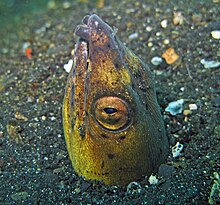| Longfin snake-eel | |
|---|---|

| |
| Scientific classification | |
| Domain: | Eukaryota |
| Kingdom: | Animalia |
| Phylum: | Chordata |
| Class: | Actinopterygii |
| Order: | Anguilliformes |
| Family: | Ophichthidae |
| Genus: | Pisodonophis |
| Species: | P. cancrivorus |
| Binomial name | |
| Pisodonophis cancrivorus (J. Richardson, 1848) | |
The longfin snake-eel (Pisodonophis cancrivorus) is an eel in the family Ophichthidae (worm/snake eels). It was described by John Richardson in 1848. It has a Dorsal fin beginning above its pectoral fin with a snake-like upper body which is cylindrical, but compressed only along its extreme tail tip. It also has a tubular nostril in front and a nostril along lower edge of the lip in back. Colors range from grey to black to brown. Large longfin snake-eels have wrinkled skin.
Inhabited Regions
Longfin snake-eels can survive in both Marine and freshwater environments, and swim from the sea up rivers to spawn. Some are found in coral reefs and live from 1 to 20 meters below the surface. They are an Indo-Pacific tropical species that lives in the Red Sea region surrounded by East Africa, French Polynesia, Ogasawara Islands and Australia.
Biology
Members of this species are typically 50 cm long, but may grow as long as 108 cm including their tails. They are born as males, but some transition to become females at maturity.
Longfin snake-eels are often found in lagoons and estuaries that as they enter freshwater. Loose groups of the eels congregate in tidal channels with their heads peeking up from below the surface. Anglers catch them with bag nets in estuaries and tidal areas.
References
- ^ Richardson, John (1948). "Pisodonophis cancrivorus (Richardson, 1848): Longfin snake-eel". fishbase.org. FishBase. Retrieved 2024-04-17.
- Riede, K. (2004). Global register of migratory species - from global to regional scales. Final Report of the R&D-Projekt 808 05 081. Bonn, Germany: Federal Agency for Nature Conservation. p. 329.
- Allen, G.R.; Erdmann, M.V. (2012). Reef fishes of the East Indies. Tropical Reef Research. Vol. I–III. Perth, Australia: University of Hawai'i Press. ISBN 9780987260000.
- Rahman, A.K.A. (1989). Freshwater fishes of Bangladesh. Department of Zoology, University of Dhaka, Bangladesh: Zoological Society of Bangladesh. p. 364.
- "The IUCN Red List of Threatened Species". IUCN. 2023.
- Rainboth, W.J. (1996). Fishes of the Cambodian Mekong. FAO species identification field guide for fishery purposes. FAO, Rome, Italy: FAO. p. 265. ISBN 92-5-103743-4.
- Kuiter, Rudie Herman; Tonozuka, Takamasa (2001). Pictorial guide to Indonesian reef fishes. Part 1. Eels- Snappers, Muraenidae - Lutjanidae. Zoonetics, Australia: Smithsonian Libraries. p. 1-302.
- Kottelat, Maurice; Whitten, Tony; Nurani, Sri Kartikasari; Soetikno, Wirjoatmodjo (1993). Freshwater fishes of Western Indonesia and Sulawesi. Hong Kong: Periplus Editions. p. 221. ISBN 978-0-945971-60-3.
External links
| Branches of biology | |
|---|---|
| |
| See also | |
| Aquatic ecosystems | ||||||||||||||||||||
|---|---|---|---|---|---|---|---|---|---|---|---|---|---|---|---|---|---|---|---|---|
| ||||||||||||||||||||
| ||||||||||||||||||||
| Fishery science topics | |||||||||||||||||||||
|---|---|---|---|---|---|---|---|---|---|---|---|---|---|---|---|---|---|---|---|---|---|
| |||||||||||||||||||||
| |||||||||||||||||||||
| Taxon identifiers | |
|---|---|
| Ophichthus madagascariensis | |




